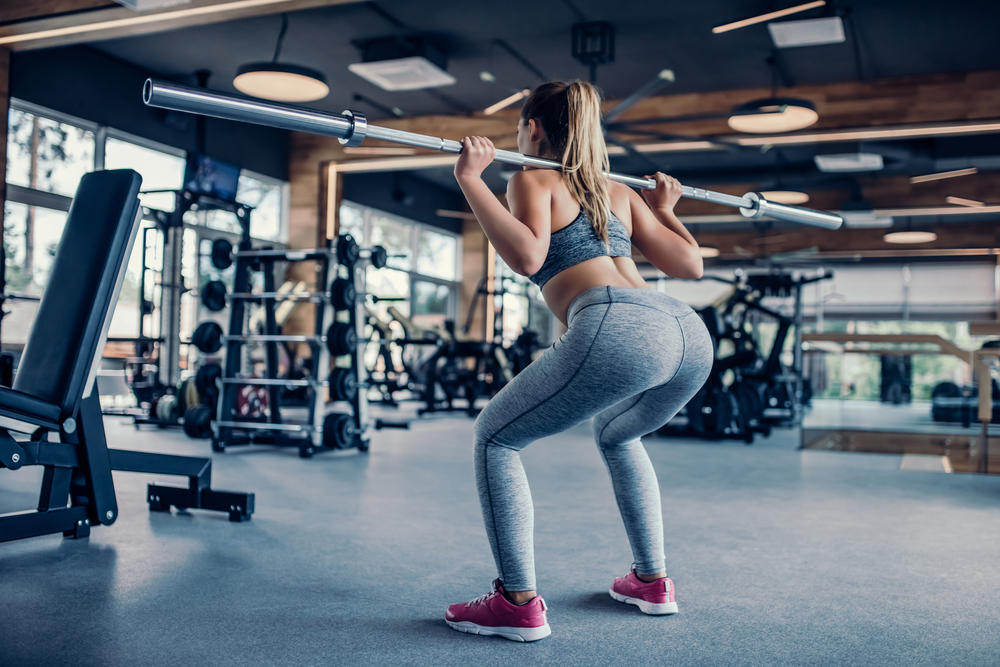If you’re looking to tone your thighs and glutes, you’ve probably been told that you must try squats. A common question I get asked is, “what are the different types of squats, and which ones should I focus on?” My answer is rather simple, you should try every type of squat to see for yourself.
Squats are one of the best compound exercises for toning and building strength in the lower body. Since most squat variations require you to hold weight, this forces your core to work hard in order to stabilize your body resulting in a great abs workout too! I have listed 10 different types of squats below for you to go and try out at the gym or at home.
Back Squats
This type of squat requires you to place a barbell on your upper back before performing the squat. Completing back squats is a fantastic way to build up your core strength as well as your lower leg strength as it works multiple muscles.
When starting, make sure to go slow when adding weights onto the barbell and it’s best if you have a personal trainer check your technique to avoid injury.
Split Squats
There’s no better exercise to develop strong quadriceps (thighs) and groin muscles than the split squat. This type of squat can be completed with either a barbell or dumbbells and your back leg elevated on a bench.
With your back leg elevated on the bench, slowly lower into the squat position and then rise back up. If you’re looking to build your glutes (buttocks) then you’ll definitely want to add in a set of split squats during your next leg workout.
Zercher Squats
Some people can’t hold a barbell on their upper back when squatting due to shoulder or low back issues. To work around this, the Zercher squat was created.
This is where you hold the barbell in the crease of your elbows, taking the load off your shoulders and lower back.
Box Squats
This style of squat can be implemented when you’re trying to progress your squat depth. Oftentimes, gym-goers won’t lower down close enough to the floor to get the full impact of the squat.
By placing a box or a bench behind you, you will have a target to sit on. This allows you to get deeper into the movement and it also provides the security of something to sit down on just in case.
Front Squats
Front squats can be completed with either a barbell, dumbbells, or kettlebells. For this exercise, you’ll hold the weight of your choice close to your chest, just below your chin. By doing this, you bring your center of gravity forward, placing more emphasis on your quadriceps muscles when completing the squat.
Goblet Squats
This fancy name refers to the position of your arms and hands when holding the weight. Grab either a dumbbell or kettlebell using both hands and hold it high up on your chest.
Next, slowly lower into the squat and rise back up squeezing your thighs and glutes.
Squat Pulses
Adding tempo squats into your routine can really help you tone your thighs and glutes. You can complete tempo squats with whatever weight you’d like.
Try to squat down with the weight as low as possible while maintaining good form. When you get down as far as you can go, complete ten mini pulses at the bottom of the squat and then return to standing upright.
Sissy Squats
Popularized by Arnold Schwarzeneggar decades ago, this squat variation is best known for helping bodybuilders build up their quadriceps, core, and hip flexor strength simultaneously.
Sissy squats are performed without any weight, meaning you’re only using your body weight. Come onto your toes while extending your upper torso backward, maintaining your balance.
Isometric Squats
A great way to build strength into your lower legs is by completing isometric squats. This exercise will take absolutely everything out of your legs, so it’s best to include these towards the end of your workout.
Pick an appropriate weight, lower into a squat, and hold this position for 3 to 5-seconds. Then rise back up to the standing position.
Squat Jumps
What better way to build muscle and burn fat than by completing jump squats? This movement requires you to squat down and then jump off the ground on the way back up.
Jump squats are fantastic for building explosive power in your legs and are often used in sports training.
Getting Started
I always recommend that you get a personal trainer to demonstrate these exercises to you, especially if it’s your first time trying squats. After all, you don’t want to be that person that struggles to climb the stairs after leg day, am I right?
Seek out help from a professional to make sure you’re completing squats correctly. This will help you avoid injury and also helps ensure you’re getting all the benefits out of these exercises.












